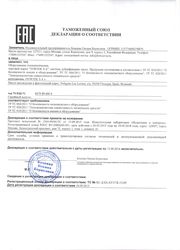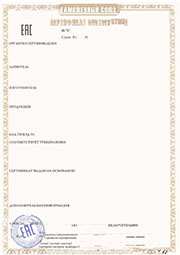What is the Eurasian Union?
The Eurasian Economic Union (EAEU) is an international regional economic integration organisation with international legal personality, established by the Eurasian Economic Union Treaty.
The Treaty on the Eurasian Economic Union (EEU) was signed on 29 May 2014 in Astana (now Nur-Sultan, Kazakhstan) by the Presidents of Russia, Belarus, and Kazakhstan. It entered into force on 1 January 2015.
Armenia (since 2 January 2015), Belarus, Kazakhstan, Kyrgyzstan (since 12 August 2015) and Russia have the status of EEU Member States. On 14 May 2018, Moldova was granted observer status.
The area of the EEU countries is over 20 million square kilometres (14% of the world's area) and the population of the EEU countries at the beginning of 2022 was 184.26 million people.
The EAEU ensures the free movement of goods, services, capital, and labour, as well as a coordinated, harmonised or unified policy in key sectors of the economy.
The customs regulatory system is common for the Eurasian Union member countries, therefore, products bearing the EAC mark can be placed on the markets of the 5 EAEU member countries.
Eurasian Economic Commission
The Eurasian Economic Commission (EEC) is the permanent regulatory body of the Eurasian Economic Union (EAEU). It started work on February 2, 2012. The main purpose of the Eurasian Economic Commission is ensuring the functioning and development of the EAEU, and introducing proposals for the further development of integration.
The complete texts of the technical regulations in Russian with their latest amendments are available on the website of the Eurasian Commission.
In our e-shop you can buy texts in English and/or in French of technical regulations of the Eurasian Union with comments of the experts of CCIS-Expertise.
List of products subject to conformity assessment within the Eurasian Union
The common list of products subject to conformity assessment within the Eurasian Union with the issuing of conformity certificates / declarations (Agreement No. 620 of the Customs Union Commission dated 7 April 2011) is available on the website of the Eurasian Commission.
The EAC certification and EAC declaration are required for all products, which are listed in the common list of products to be certified within the EAEU under decision of the board of the Eurasian Economic Commission No. 620 from 7 April 2011. For the products which are not listed, there is a national regulation in place that is required for import and sales.
What is an EAC Declaration of Conformity?
A Declaration of Conformity (DoC) is an official certificate drawn up by the manufacturer or their authorised representative (applicant). It is a mandatory document prescribed by most of the Eurasian Technical Regulations (EAEU Technical Regulations or CU Technical Regulations). The DoC declares that a product is in compliance with all relevant Eurasian product safety requirements.
How do I obtain an EAC Declaration of Conformity?
Drafting a Declaration of Conformity is an important part of the EAC marking process. It is the final step before affixing the EAC mark to your product. Before writing the Declaration of Conformity, you must have carried out these steps:
-
Identify the EAEU Technical Regulations or CU Technical Regulations for your product
-
Check whether your product meets specific requirements
-
Test your product in an Accredited laboratory in the Eurasian Union
-
Compile a technical (certification) file
The EAC Declaration is issued by the manufacturer, importer or an authorized representative on A4 paper on their own. The declaration has to be issued with signature and company stamp. The EAC conformity mark and a unique QR code is applied to every declaration.
What is an EAC Certificate of Conformity?
The EAC Certificate is a document issued by a certification body, based on test reports and audit of the manufacturing site (if required according to the technical regulation).
Each model of an ordered product should be subjected to adequate tests, have its own certificate or be regrouped into one certificate with other similar models is the technical regulation allows for it.
How do I obtain an EAC Certificate of Conformity?
-
apply to an accredited certification body within the EAEU
-
the certification body examines your documents
-
identification of the product and selection of samples
-
tests and analyses
-
audit of the manufacturing site (if required according to the technical regulation)
-
the certificate is issued
-
monitoring of the certified products (if required)
The EAC Certificate is issued by the certification body on an official form. Every form has a series and identification number. The certificate is counterfeit-proof.
What is the difference between EAC declaration of conformity and EAC certificate of conformity?
A declaration of conformity is registered by the manufacturer, importer, or authorized representative (applicant). In this way the economic operator states under his own responsibility that its product complies with the applicable standards of Technical Regulations.
A certificate of conformity is edited by a third part (certification body) after having performed the type tests as witness and manufacturing audit procedure.
Validity of an EAC certificate and an EAC declaration
The validity is specified in technical regulations of the Eurasian Union. The maximum validity period is 5 years.
Which EAC Technical Regulation is applicable for your products?
A new "Guidelines" tool proposed by CCIS-EXPERTISE allows producers/exporters in two clicks to find out which certificates/documents are needed and which regulation is applicable in order to be able to put their products on the Eurasian market.
The tool, which is developed and regularly updated by CCIS-EXPERTISE experts, lists the products identified by the first four digits of the HS Code and the possible countries of destination: Armenia, Belarus, Kazakhstan, Russia, and Kyrgyzstan.
We offer solutions for:
-
obtaining documents of conformity (declaration / certificate);
-
advising on products’ identification, compiling a certification file, elaborating product labels;
-
organizing and supervising the audit of production sites together with accredited experts;
-
conducting tests of your products in accredited laboratories;
-
elaborating technical specifications for voluntary certification.












